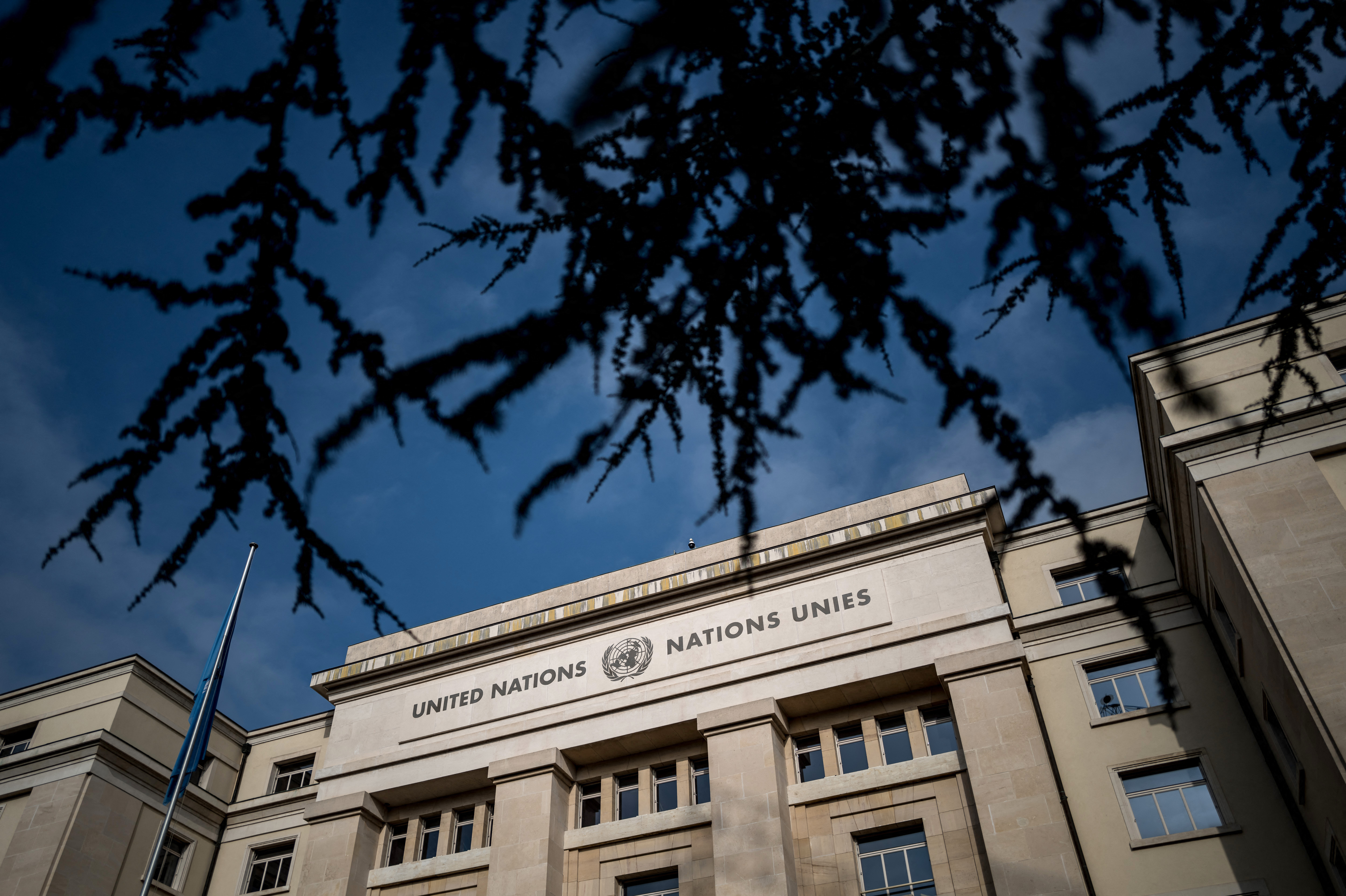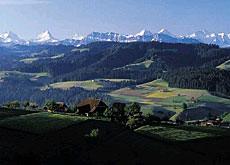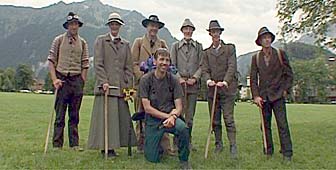Seeing Switzerland through other eyes

Visitors to the Swiss National Library in Bern are currently being invited to take a journey through Switzerland – and a journey through time.
The library has put on a small exhibition giving a tantalising overview of some of the thousands of guidebooks to the country that have been published over the past couple of centuries.
Curator Beat Gugger has selected about 300 out of the 30,000 or so in the library’s stocks. As he told swissinfo.ch, the aim is to give an overview, and the selection is “super subjective”.
While plenty of research has been done on travel descriptions, very little has been done on guides. “We hope to encourage it,” he said.
But what a treasure trove the library owns! What fun future researchers will have when they get round to it!
Well-heeled travellers
Guidebooks developed gradually out of the accounts travellers used to publish of their impressions.
The first book which concentrated simply on facts appeared in 1793, written by Johann Gottfried Ebel, a German doctor working in Zurich. There was no doubt about its aim: it was called: “Guide to the most useful and enjoyable way of travelling through Switzerland”.
There is nothing surprising about the fact that the author was not Swiss: wealthy English and Germans were the pioneers of this kind of leisure travel. Indeed, foreign tourists helped to create the image Switzerland had – and has – of itself.
In the age of Romanticism, when philosophers were talking enthusiastically of the “noble savage”, the Swiss – a people who had never had a king – seemed to be Europe’s closest equivalent, living in man’s “natural condition”, Gugger explained.
Foreign aristocrats loved the display of traditional Swiss customs that their Bernese counterparts invited them to witness at the Unspunnenfest in 1805, a popular festival at which peasants were invited to show off such skills as yodelling and playing the alphorn.
“The Swiss soon realised what the foreigners came to see. They started to say: ‘If that’s what they want, that’s what we’ll give them.’”
Changing taste
Guidebooks offer an insight into changing taste. An absolute must in the early years of tourism was a 1751 funeral monument in the church in Hindelbank near Bern.
It commemorates the wife of the parson there who died in childbirth and shows her and her child bursting forth from their tomb as they are resurrected for the Last Judgement.
One corner of the exhibition compares how the earliest guidebooks covered this attraction.
As an introduction, Sophie Laroche, writing her travel memoirs in 1787, describes how moved she was by the monument.
The influential British Murray Guide of 1838 remarks snootily (but to modern taste probably correctly) that “its merit as a work of art has been much exaggerated”.
And a 20th century guidebook describes the baroque château in Hindelbank, but ignores the tombstone altogether.
Glimpses of history
Gugger has chosen pages which give fascinating glimpses of Swiss history. An 1877 guide is displayed to show a description of Brunnen on Lake Lucerne, where Switzerland’s founding document is kept – a document of 1315.
The book was published before the oath of 1291 was regarded as laying the foundation of the confederation.
A Gotthard Guide of 1883 capitalises on the widespread interest in the just-opened rail tunnel, then the longest in the world. It contains a map of the circular tunnels which enabled the trains to gain height – something many modern travellers would doubtless appreciate as the train mysteriously seems to change direction each time it emerges.
A Russian guide of 1912 tells its readers that although it currently takes four hours to walk from Kandersteg to the Gemmi pass, a railway tunnel will shortly be opened. That was the Lötschberg, which indeed came into operation in 1913.
Gugger chose that particular guidebook for a different reason, however. On the same page is a description of the Kiental, also in the Bernese Oberland.
“Lenin and Trotsky went to the Kiental to hold a meeting of the Comintern, camouflaged as members of a birdwatchers’ association. I thought it would be amusing to show the Kiental page – Lenin could have used this guide to find out about the place.”
Guides for today
The exhibition has plenty of modern guides too, which show how tastes continue to change.
“Around the 1970s the idea started to gain ground that tourism can create problems, so here you have alternative guidebooks, like this one suggesting that you don’t fly anywhere but travel at home. It’s printed on environmentally friendly paper,” said Gugger.
A more recent – and probably more expensive way – to stay at home is described in another guide book featuring “wellness” hotels: since the 1990s instead of travelling, you go to relax to recover from your daily stress.
Guides for the wealthy, guides for families, guides for youngsters, guides in foreign languages… The attractions of Switzerland are in the eye of the beholder.
Julia Slater, swissinfo.ch
The exhibition is on at the National Library in Bern until June 27.
The library probably owns the biggest collection of Swiss guide books anywhere in the world.
The first guide book advising travellers of what to see was published in 1793.
The Englishman John Murray (1808-92) published influential guidebooks of many countries, full of practical information.
His example was followed by Karl Baedeker (1801-59) in German.
They contained information about such things as hotels and transport as well as the sites.
The first Baedeker guide to Switzerland appeared in 1844. The guides were published in German, French and English.
The French tyre manufacturer Michelin started publishing guides in 1900, to encourage drivers to travel.
The first Michelin guide to Switzerland came out in 1908, but after that the next guide devoted entirely to Switzerland was not published until 1994.
Murray was the first to introduce a rating system for sites, in 1836.
The writer‘s intention in this guide is to afford the foreigner in Switzerland richest and most complete enjoyment of nature in all its forms; to direct his attention to many things which are easily overlooked, and to put him in a position to travel through this curious country in as useful a way as possible in every regard.
The star (*) by the name of a hotel shows that the writer or his friends considered that the food and accommodation were good value for money on the day they visited. But since such things can change rapidly, and depend to a great extent on the requirements of the particular individual, whose character also influences his judgement, no reasonable traveller will hold the writer responsible for the absolute reliability of his stars.

In compliance with the JTI standards
More: SWI swissinfo.ch certified by the Journalism Trust Initiative













You can find an overview of ongoing debates with our journalists here . Please join us!
If you want to start a conversation about a topic raised in this article or want to report factual errors, email us at english@swissinfo.ch.